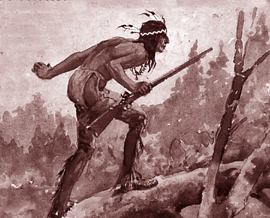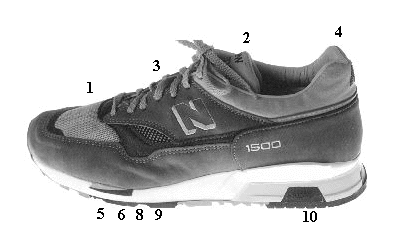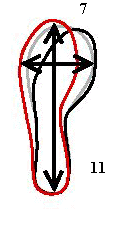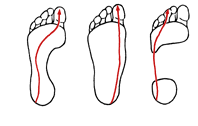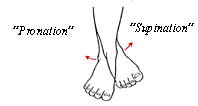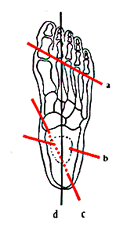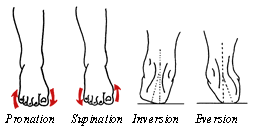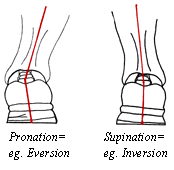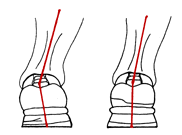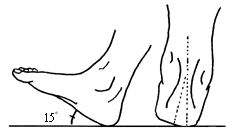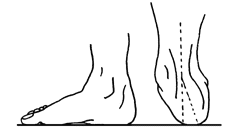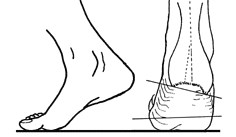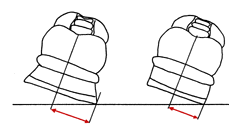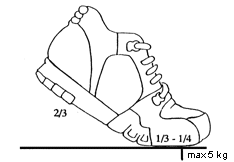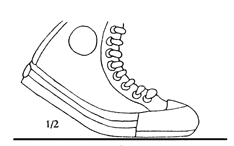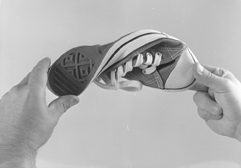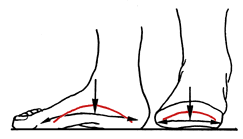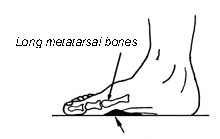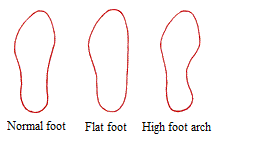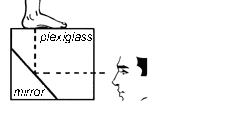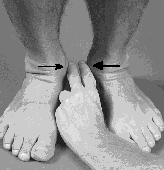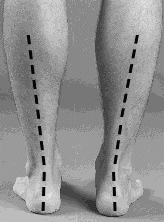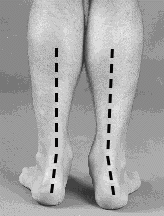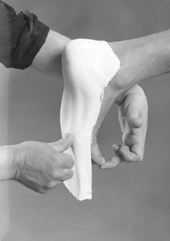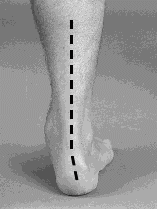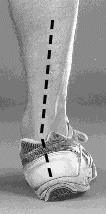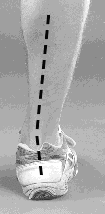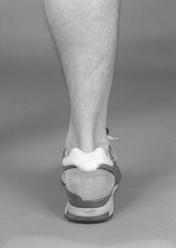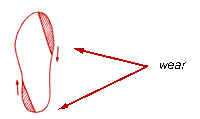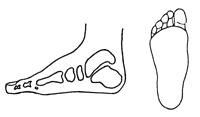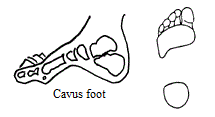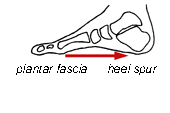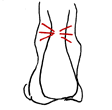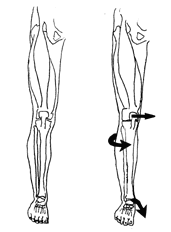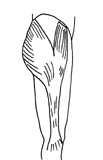Shoe analysis
Introduction
|
|
|
Inferior
or incorrect shoes can be directly linked to many problems beyond immediate
foot and exercise discomforts: the lower legs, knees, hips, the lower back
and even further up the spine have been shown to be adversely affected. |
In the
following chapter, we will present in a concise manner our rationale when
analyzing feet and shoes, as well as the advice we share with those we meet
in our daily work. |
|
|
|
|
A boot
must protect against water, but a trekking boot must also support the foot to
hinder movement and ensuing blisters. A hunting boot, in our latitudes, must
insulate against the cold while the hunter stands still in the forest and thus some
support must be sacrificed to ensure there is enough space around the foot
for heavy socks - for that important insulating layer of air. In the Wild
West the boot was designed for use in the saddle and as protection against
snakebite, an almost impossible design for walking longer distances, but for
its' specific purpose the boot was highly functional. |
A shoe or boot's usage most often determines
its' shape or style. However the footwear's inner construction and
suitability for the foot, based on foot anatomy and function is most critical
and is what the latter part of this chapter is all about. But first, we will
concentrate on the walking- and jogging shoes and their characteristics. |
|
7. Space
for your toes: your toes need room to work and breathe! |
Many
running shoes can be found in two widths (men's and women's), but there are
also quality brands offering as many as seven different width sizes (4 men's,
3 women's), which increases your chances of finding shoes that will truly
fit. Note that not all shoe stores are either aware of the selection
available, or have bothered to stock more than a few of the basic widths in
each model! |
|
1.
Weather resistant, breathable uppers. |
7.
Generous toe space. |
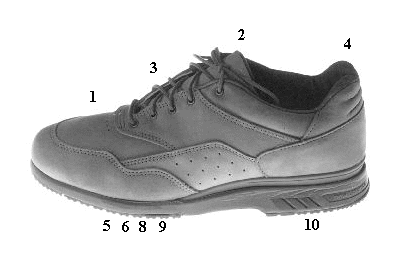
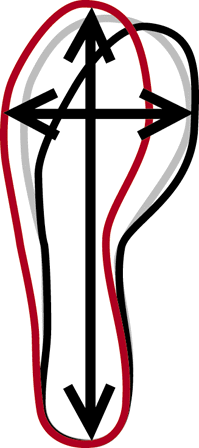
"Example of a good walking shoe"
|
Criteria
for a good jogging shoe |
A runner,
who switches from an indoor track to an outdoor asphalt track, should do so
with care, increasing his duration on the asphalt in stages while carefully
assessing the nature of his shoes' heels and soles. Incorrect or poor shock
absorption or too soft a sole may result in foot or leg injuries. |
|
1.
Weather resistant, breathable uppers. |
7.
Generous toe space. |
|
|
|
|
The
anatomy of the foot with its' many joints is complex. For the benefit of shoe
customers we present a synopsis of the mechanics of the foot's movements in
order to properly illustrate the basis of shoe construction. |
1. Upward flexing (dorsal flexing) of the ankle joint 2. Outward
angling (eversion) of the heel |
|
|
|
|
The shoe
itself may be crooked in its' entirety or compressed/crooked in the heel. In
persons with such physical problems, the deviation in the shoes' heels must
first be corrected until the shoe is straight, regardless of the degree of
eversion present. |
Phases
of the step |
|
However there is no rule to this. Other movements
occur which are difficult to detect if one is not observant during video
analysis! |
But on
the outside of the shoe when supination is present. |
The Shoe's Heel
|
Long distance runners should use shoes with approx. 1-1,5 cm (1/2 inch)
heels.
6. Heel width on shoes for a normal runner should not exceed 7 - 8 cm. A normal heel width is better than wider ones, which can greatly strain the inner leg muscles when they strive to alleviate the transverse torsion at the moment of impact with the ground. To counteract an incorrect impact angle, the heel can be narrowed/widened differently per side. For correction of inversion, the heel should be widened or hardened on its' outer edge, while for eversion the converse would apply. 7. The heel's degree of hardness and shock absorption is of great importance to the comfort of the shoe while running. A heavy person or hard track surfaces requires a better degree of shock absorption. A good shoe should not, at the moment of impact, allow the heel to tilt excessively inwards or outwards but should remain somewhat straight. In the case of shoes specifically for moderate running speeds, a slight inward tilt is allowable. 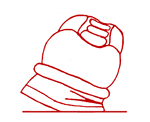 Many shoes are too soft in the heel's outer edge. At the moment of impact, the heel material is overly compressed, leading to problems due to unacceptable inward tilting / deviations in the heel angle. Old shoes, with worn-down soles or uppers can often cause this same problem. |
|
Note! This problem in a shoe can be
almost impossible to detect without video analysis. There are many different
heel designs available to optimize weight distribution in this area of the
shoe. The air-pillow design is currently available from different
manufacturers, but all do not guarantee optimal results - in many cases,
quite the contrary! There are other excellent designs as well! An analysis of
each runner's steps when using a specific shoe is clearly critical. The Heel Cap
|
|
|
|
|
|
Arches of the foot |
|
|
|
|
|
|
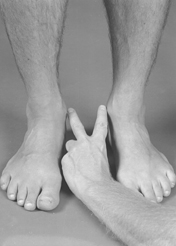 "The examiner's "V-sign" with fingertips placed against the inner ankle bones."
|
|
|
|
|
|
(I.e.
when the big toe's tendon is stretched due to the big toe's upward angle). |
|
|
|
|
For example, the runner who seems to pronate
at jogging speed may well exhibit a "normal" step at higher speeds
(increased speed as a rule causes more supination). This runner should not
use (anti) pronation shoes for
running at high speed! If the treadmill has insufficient speed while video
filming, this problem can easily be overlooked. It is therefore critical to
always base the video analysis and testing on the type of activity for which
the shoes will be used! |
|
|
|
|
|
Shoes
wear out in different ways: visible wear, and inner fatigue. |
This may
result in for instance a twisted ankle or that the natural forward
"roll" in the footstep is imbalanced, causing pain / discomfort. |
|
|
|
|
Go to
another shoe store! A service-minded shoe salesman with the education
described above, has a decided sales advantage. Customer satisfaction,
translates into future sales over the years. Finally: Don't be blinded by
designer labels or price tags. Those expensive shoes may well have been
designed with characteristics that in no way fit your needs! Famous companies
known for good products also issue cheaper variations on the market (i.e.
shoes with poor quality, shock absorption and stability). Choose a shoe based
on information and a critical eye as to its' quality and characteristics. Most
important is that the shoe truly fits both you, and the specific activity for
which they are purchased. |
* The shoe
with the best test result may not be the best for you! |
|
|
|
|
Problems
and discomforts: preventable and curable with a better choice of shoes. |
|
|
|
|
|
Stiff Feet |
Treatment |
|
|
|
|
Treatment |
Stiff
Big Toe (hallux rigidus) |
|
|
|
|
Inflammation
in muscles, tendons, and their points of attachment to the bone |
Knee
Discomforts |
|
|
|
|
Runner's
Knee |
Sprains
and Ligament Injuries in the Foot. |
